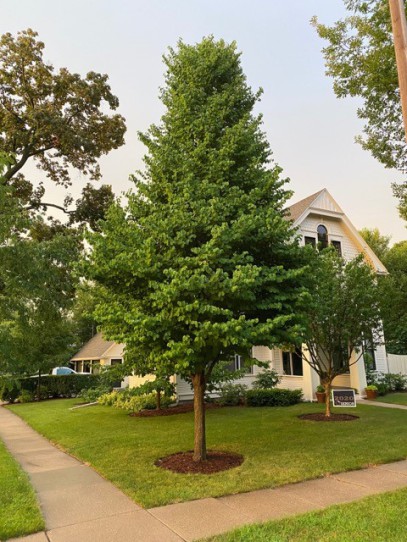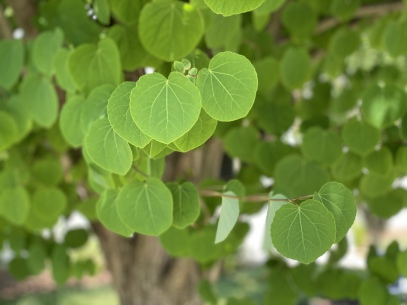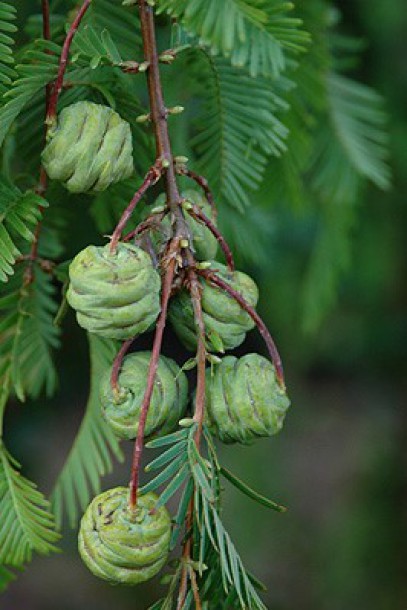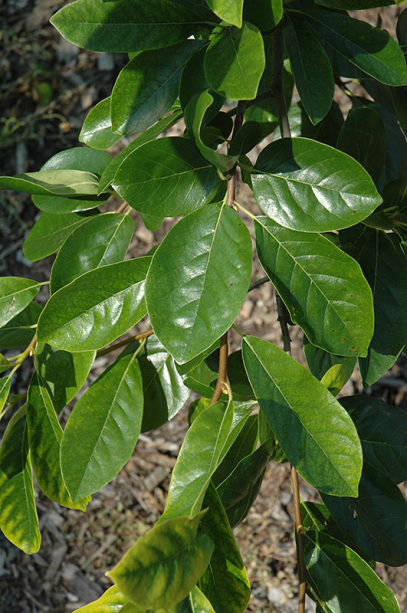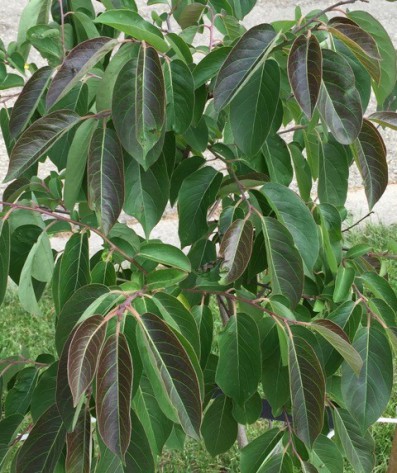
Shade Trees for Sale
Mature height 25 feet and taller
Trees delivered to your door (rates available by request) or schedule convenient curbside pickup in downtown Cambridge seven days weekly 8am-8pm.
Reserve your order by email or phone: info@cambridgetreeproject.org
608-513-1977
Buckeye, Ohio
(Aesculus glabra)
Buckeyes are great choices for shaded areas given their adaptation to life in the forest understory. They also tolerate challenging soils (poor drainage, rocks, and clay) and happily thrive in sunny, open locations. All but one of the 39 buckeyes planted throughout Cambridge over the past 18 years are alive today, making the species one of the most durable trees studied in our tree trials. Palmately compound leaves (see pictures above) stand out among other trees. Attractive yellow flowers (also pictured above) arrive in June and in fall buckeye nuts appear only to be quickly swiped by local squirrel packs. Leaves consistently offer a nice pumpkin orange fall color while deeper reds appear occasionally. Buckeyes are long-lived trees (to 200 years) but growth is slow: our 13 street and park trees in Cambridge average only ten inches annually. Reaches 40 ft. tall and wide.
NOTE: Juvenile Ohio buckeyes have no side branching.
6 ft. tall seedling (potted): $75
Did you know?
The Village of Cambridge's urban forest has 175 different species of trees, the most of any municipality in Wisconsin.
Coffeetree, Kentucky
(Gymnocladus dioicus) Native and Deer Resistant
Coffeetree combines elegance and toughness so well that it's become one of the most popular urban trees planted in our area. Sparse looking when young, but with time they become highly picturesque specimens (see top pic, above). Exceptional yellow fall color (middle photo, above) appears nearly every year locally, and the attractive, highly textured scaly bark (bottom photo) is a four-season attraction. Female trees have large purple seed pods that turn dark brown and persist through winter months. Coffeetrees succeed in all soils except those that are continually wet. They also tolerate deep shade as seedlings. 38 coffeetrees planted along Cambridge streets in poor soil (gravel, in some cases) average an impressive 20 inches of growth annually. Trees planted in better soil will add between two and three ft. of annual growth as juveniles. Reaches 50 ft. tall and 40 ft. wide in the home landscape. The second tallest coffeetree in America (112 ft.) is found just south of Cambridge near Lake Koshkonong.
NOTE: Juvenile coffeetrees have no side branching.
2 ft. tall seedling (potted): $35
Gift Certificates
- Birthdays, House Warmings!
- Email us for details: info@CambridgeTreeProject.org
Ironwood
See 'Ornamantals' tab, above
Katsuratree
(Cercidyphyllum japonica)
Considered by tree aficionados to be one of the most beautiful and desirable specimen trees. Extremely long lived (some are known to be over 1000 years old), low maintenance and attractive in all seasons. Leaves have an interesting round shape that flickers in the wind throughout summer, remaining disease free well into autumn when they turn a golden yellow to apricot color locally (see middle picture, above). Their only liability is the need for good garden soil and regular watering when young. A katsura growing in the Nakoma neighborhood in Madison is 65 ft. high. We're recording 15 inches of annual growth from the 21 katsuras planted throughout Cambridge, mostly in shaded conditions, where growth rates are suppressed. Those planted in sunny locations have averaged 20 inches annually over the past ten years.
5 ft. tall (potted): $95
Larch, American (Tamarack)
(Larix laricina) Native and Deer Resistant
This fascinating deciduous conifer drops its needles every fall after displaying golden yellow color (see top pic above). Decorative small cones (to one inch) are violet colored when young (see photo directly above) before turning light brown. Easy to grow locally in saturated soils or under normal lawn and garden conditions. Though far more common in northern Wisconsin, glacial remnant tamarack populations can be found in the Madison area, including swamps on the south end of Rock Lake near Lake Mills. Fast growing when young, up to 24 inches annually on the eight street trees here in Cambridge. Reaches 50 ft. tall and 20 ft. wide and is known to be long-lived, reaching up to 180 years old.
3-4 ft. tall: $60
4-5 ft. tall: $75
Musclewood
See 'Ornamantals' tab, above
Oaks
(Quercus bicolor, macrocarpa, rubra) Native
Oaks are majestically beautiful, easy to grow and live longer than most landscape trees. Known as nature's cafeteria, they support more life-forms than any other tree in North America.
Bur Oak handles tough conditions better than nearly any other tree: dry, gravelly, rocky, or compacted clay soils, occasional flooding, wind-exposed, take your pick! An excellent choice for newer subdivisions; where even under terrible soil conditions bur oaks average eight inches of annual growth locally. In better soil we've found bur oaks will grow 20 inches annually within the first five years of planting. With time a large tree, up to 75 ft. tall and wide. Long-lived, reaching 200-300 years old.
4 ft. tall (potted, pictured top left) $60
5 ft. tall (potted, pictured top right) $75
Red Oak is one of the few oaks that's shade tolerant; as such it was our "go-to" tree to underplant ash trees we knew would succumb to the emerald ash borer in our village forest. Growth in shaded settings is eight inches annually based on our seven trees in Cambridge. When planted in sunny locations, however, we're recording over 20 inches of annual growth. Very easy to grow locally and long-lived, reaching up to 300 years old. Nice red fall color most years (see picture above, taken at Pleasant and Main Streets). Reaches 60 ft. tall and wide.
Available spring 2025 by special order
Swamp White Oak has become a popular urban tree due to its renown tolerance of poor soils, both wet and dry. Offers glossy, dark green leaves and attractively shaggy bark. Swamp white oak leaves are known to be among the best sound insulators of any deciduous tree, given their combined glossy upper surface (sound reflection) and fuzzy underside (absorption). The growth rate of 17 swamp white oak street trees in Cambridge is 16 inches annually. Those planted in better soils, when regularly mulched and watered, grow between two and three ft. annually as juveniles. Easy to grow in any sunny setting.
Available spring 2025 by special order
Pecan, Northern
(Carya illinoinensis)
While known as a southern species, we carry pecans sourced from northern locations that perform well in our area. Our four trees in Cambridge survived temperatures as low as -32F during the polar vortex in late January 2019. A ten year old tree near Westside Park (pictured at top, above) started producing pecans in the fall of 2018. Pecan trees are self-fertile and our trees begin producing nuts about eight years after planting. Four pecan trees planted locally have managed an impressive 22 inches of annual growth over the past decade in less than ideal soil. They're also tough: able to withstand exposed areas, compacted clay and seasonally wet soils. Reaches 70 ft. tall and 40 ft. wide. We've seen a nice yellow fall color locally about every other year.
18-24" tall (potted) $35
Redwood, Dawn
(Metasequoia glyptostroboides) Deer Resistant
An exotically beautiful deciduous conifer similar to baldcypress but faster growing locally: our 16 trees in Cambridge average 20 inches of annual growth without supplemental watering; in better soils we've noted between two and three ft. of growth annually. Dawnredwood is also the most cold tolerant redwood known: our trees withstood -30F ambient temperature during the polar vortex in 2019 with no damage. Interestingly attractive cones (pictured immediately above) are only one inch across - very small for a conifer. Handsome reddish brown, fissured bark provides all season appeal (see middle photo above). Withstands wet soil but also performs well in drier spots. Also tolerates compacted clay soils making it great choice for newer homes where soils have been disturbed. Reaches 70 ft. tall but stays narrow to only 25 ft. wide.
6 ft. tall (potted): $95
Tupelo
(Nyssa sylvatica) Deer Resistant
A tupelo tree's exceptionally vivid red fall color on glossy leaves is nearly impossible to beat on a clear fall day. Pictured at top, above, is a celebrated specimen growing next to the McKay Center at the UW Arboretum: note the unique horizontal branching pattern. Additionally, tupelo is known to be one of the best trees for pollinators such as bees, flies, beetles, and wasps. Grows in poorly drained areas given its tolerance of anaerobic soils. Tolerates all soil types locally and is resistant to heat and drought. The growth rate of our eight tupelo trees in Cambridge has been slow, at 12 inches annually. Reaches 30 ft. tall and wide locally. This tree is also long lived, reaching up to 500 years old. Native only to Kenosha County in Wisconsin, but fully hardy in our area.
3-4 ft. tall (potted, pictured immediately above): $60
4-5 ft. tall (potted): $75
Special Order Shade Trees
We stock the following shade trees in the fall and spring and would be happy to reserve one for you.
info@cambridgetreeproject.org
608-513-1977
Sassafras
(Sassafras albidum)
All parts of Sassafras are aromatic and interesting. The roots were once used to make root beer and tea. Sassafras leaves come in four different shapes (ghost, football and both left and right-handed mittens) and feature exceptional orange and red fall color locally (pictured above). Ornamental dark purple seeds on bright red stalks (middle picture above) also appear in fall. Color also appears in spring, in the form of yellow flowers. Four Sassafras trees planted throughout Cambridge are growing quickly, averaging 22 inches of growth annually. Needs full sun and good soil to thrive.
Available fall 2024 by special order
Sycamore
(Platanus occidentalis) Native and Deer Resistant
No quality shade tree is tougher or faster growing than a sycamore. To be sure, the fastest growing tree we've ever measured in our tree trials (pictured at top, above) is a sycamore planted in 2006 on the 200 block of North Street in Cambridge; that tree is now 55 ft. tall and has averaged 43 inches of growth annually. Overall, 25 sycamores located in poor soils throughout Cambridge average 29 inches of annual growth without supplemental watering. They happily grow in any sunny setting, tolerating wet, dry, clay and even gravel soils and rarely need formative pruning due to a nicely defined central leader and measured lateral branching. Ornamental bark (middle picture, above) is an all-season attraction. Their mature size is massive, up to 100 ft. tall and wide. Trees are known to be 600 years old.
Available fall 2024 by special order
Birch, Yellow
(Betula alleghaniensis) Native and Deer Resistant
A hard to find top-tier shade tree featuring shiny golden bark and exceptional clear yellow fall color (both pictured above). Yellow birch is the only native birch known to be shade tolerant and is our longest-lived birch, reaching up to 300 years old. Features the essence of wintergreen in its twigs, which were historically distilled to flavor food products. This is our largest birch (to 60 ft. high) and is logged for flooring, trim and furniture. Two yellow birches planted on Cambridge school grounds in 2012 average 15 inches of new growth each year. Grows in sun or heavy shade and prefers deep garden soil with protection from afternoon sun.
Available fall 2024 by special order
Persimmon
(Diospyros virginiana) Deer Resistant
A tough and interesting tree that's performed well for us here in Cambridge despite its natural range extending no further north than central Illinois. Most prominent feature is handsome and easily recognized blocky bark (see top picture above). Persimmons also have lustrous dark green leaves that emerge purplish red in spring (middle picture above). We've planted 19 throughout Cambridge (mostly in poor soil conditions) where they average 14 inches of annual growth; also, none of them have died, suggesting cultural tenacity. Persimmons are considered highly shade tolerant. Their bright orange fruits (pictured middle, above) are edible and require male and female trees for pollination. A street tree on Lawn Street in Cambridge began fruiting in 2017, eight years after it was planted. The tallest persimmon in Wisconsin, located in Shorewood, is 45 ft. high.
NOTE: persimmon trees are either male or female: we recommend buying at least three trees to (hopefully) assure a fruit set.
Available fall 2024 by special order
Sweetgum
(Liquidambar styraciflua x 'Moraine') Deer Resistant
The best fall color festival in the Madison area! Sweetgum leaves from the same tree pick a brilliant color (crimson, purple or yellow) and really run with it (see photo at top, above). We offer 'Moraine', a cultivar which readily withstands our coldest winters and provides lustrous green leaves throughout summer (pictured immediately above). We’re seeing annual growth of 18 inches on the 20 sweetgums planted throughout Cambridge. An easy tree to grow, with a renown tolerance of poor drainage, flooding, drought, and heat. Long-lived (to 300 years) eventually reaching 50 ft. tall and 30 ft. wide with a regular, upswept branching pattern that rarely requires corrective pruning.
Available spring 2025 by special order
Tuliptree
(Liriodendron tulipifera) Deer Resistant
Fast growing, spring flowering, majestic member of the magnolia family. Flowers (pictured at top, above) arrive within ten years of planting and do look just like tulips. Leaves (pictured in middle of set, above) have the unique tulip profile and remain disease free (Japanese beetles won’t touch this tree) well into autumn when they consistently display vivid yellow color locally. 19 tuliptrees planted as street trees in Cambridge have averaged 24 inches of annual growth over the past decade; trees planted in residential lawns throughout our village are growing up to 36 inches annually (see picture immediately above, taken of a 15-year-old tuliptree on the 300 block of North Street). Not a good choice for areas with poor soil, especially new subdivisions. A large tree with time, reaching 80 ft. tall and 40 ft. wide and growing up to 200 years old.
Available spring 2025 by special order
Catalpa
(Catalpa speciosa) Deer Resistant
Catalpa's orchid-like flowers are said to be the most beautiful of all American flowering trees (see photo above). Massive leaves (to 12 inches) lend a tropical appearance and provide a pleasant medium green color over summer months. Long bean-shaped seed pods arrive in about ten years. Incredibly fast growing: 25 inches annually taking measurements from our 18 street and park trees in Cambridge. Grows in virtually any sunny setting including the compacted slow-draining clays common in newer subdivisions. With time a very large tree: one in Wauwatosa is 106 ft. high.
NOTE: Juvenile catalpas have no side branching.
Available fall 2024 by special order
Elm, American
(Ulmus americana x 'St. Croix') Native
Contemporary elm cultivars offer disease resistance, exceptionally fast growth and the classic vase shape which historically defined American streets and parks (see top picture, above). We offer 'St. Croix,' selected in Minnesota for exceptional disease resistance, a picturesque, open habit, rapid growth, and attractive yellow fall color (pictured immediately above). American elms are among the most durable trees for tough conditions, including the slow draining compacted clay soils so commonly found in newer subdivisions. Their only requirement for success is a sunny location. A nine ft. tall elm cultivar planted in Cambridge on Park Street in 2009 is now over 40 ft. tall (middle piscture, above). 34 elm cultivars planted throughout Cambridge along our streets average 26 inches of annual growth, those planted in better soils average three ft. of growth annually.
Available spring 2025 by special order
Ginkgo
(Gingko biloba x 'Autumn Gold') Deer Resistant
The most distinctive leaf shape of any deciduous tree in our area. Ginkgoes also display consistently brilliant yellow fall color locally (pictured above). Additionally, in most years nearly all leaves drop within 24 hours, reducing your fall raking hassle considerably. Known to be one of the most trouble-free trees available: no insect or disease issues to worry about and trees are extremely durable once established: trees in China are known to be over 1000 years old and the oldest is thought to be 3500. After a slow recovery from transplanting, slow growth commences: 65 ginkgoes planted throughout Cambridge average only eight inches of growth annually. Growth to 15 inches annually can be achieved with regular watering and a little luck. Reaches 50 ft. tall and 30 ft. wide.
NOTE: 'Autumn Gold' ginkgo is male cultivar which doesn't produce fruit.
Available spring 2025 by special order
Proceeds from our non-profit tree sales have gifted and established over 1100 additional living trees in Cambridge since 2006






